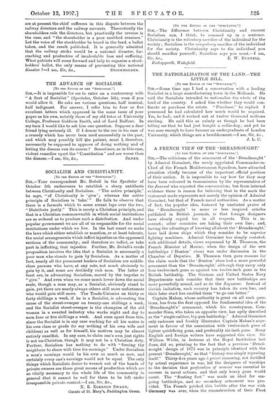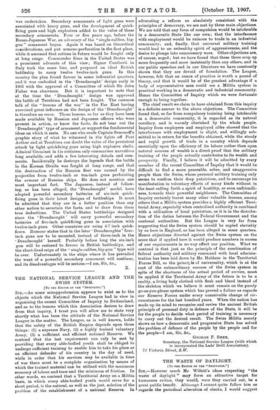A FRENCH VIE W OF THE DREADNOUGHT.'
[To rice EDITOR OP Tice "SPECTATOR."] SIR,—The criticisms of the armament of the ' Dreadnought' by Admiral Germinet, the newly appointed Commander-in- Chief of the French Mediterranean Squadron, have attracted attention chiefly because of the important official position of their author. It is impossible to say how far they may have been coloured in transmission by the representative of the Journal who reported the conversation; but from internal evidence there is reason for believing that in the main the statement made represents not merely the opinion of Admiral Germinet, but that of French naval authorities. As a matter of fact, the popular idea, fostered by unstinted praise of the Dreadnought' in more or less inspired articles published in British journals, is that foreign designers have closely copied her in all respects. This is in- correct; other countries are taking their own line ; and, having the advantage of knowing all about the ' Dreadnought,' have laid down ships which they consider to be superior fighting machines. Admiral Germinet has simply restated, with additional details, views expressed by M. Thomson, the French Minister of Marine, when the design of the new battleships (` Danton ' class) was under discussion in the Chamber of Deputies. M. Thomson then gave reasons for the claim made that the `Danton ' class had a more powerful armament than the 'Dreadnought,' although they carry only four twelve-inch guns as against ten twelve-inch guns in the British battleship. The German and United States Navy Departments each consider that their new battleships are more powerfully armed, and so do the Japanese. Instead of slavish imitation, each country has taken its own line, and their later start has enabled them " to go one better."
Captain Mahan, whose authority is great on all such ques- tions, has from the first opposed the fundamental idea of the 'Dreadnought's' armament, which his countryman, Com- mander Sims, who takes an opposite view, has aptly described as the " single-calibre, big-gun battleship." Admiral Germinet only endorses and freshly illustrates Captain Mahan's argu- ment in favour of the association with twelve-inch guns of lighter quickfiring guns, and preferably six-inch guns. Many English and foreign writers have supported this view. Sir William White, iu lectures at the Royal Institution last June, did so, pointing to the fact that a previous Dread- nought' design of 1873 was in principle identical with the present 'Dreadnought,' so that " history was simply repeating itself." Thirty-five years ago a priori reasoning, not fortified by actual experience in war, led the designers of warships to the decision that perforation of armour was essential to success in naval actions, and that only heavy guns would count. The "floating fort" was made an ideal for sea- going battleships, and no secondary armament was pro- vided. The French pricked this bubble after the war with Germany was over, when the reconstruction of their Fleet
was undertaken. Secondary armaments of light guns were associated with heavy guns, and the development of quick- firing guns and high explosives added to the value of these secondary armaments. Four or five years ago, before the Russo-Japanese War, an advocacy of the "single-calibre, big- gun " armament began. Again it was based on theoretical considerations, and put armour-perforation in the first place, while it assumed that actions in future would be fought only at long range. Commander Sims in the United States was a prominent advocate of this view; Signor Cuniberti in Italy took the same line, and proposed an ideal British battleship to carry twelve twelve-inch guns. In this country the plan found favour in some influential quarters, and it was embodied in the 'Dreadnought' design early in 1905 with the approval of a Committee of which Sir John Fisher was chairman. But it is important to note that at the time the ' Dreadnought' design was approved the battle of Tsushima had not been fought. The common talk of the " lessons of the war" in the Far East having exercised great influence on the design of the Dreadnought' is therefore an error. Those lessons, so far as they have been made available by Russian and Japanese officers who were present in action, or know the facts, do not bear out the ' Dreadnought' type of armament, or support the fundamental ideas on which it rests. No one who reads Captain Semenoff's graphic story of what he witnessed in the fights off Port Arthur and at Tsushima can doubt the value of the persistent attack by light quickfiring guns using high explosive shells. Admiral Germinet in his criticism only summarises narratives long available, and adds a few interesting details and com- ments. Incidentally he destroys the legends that the battle in the Korean Straits was fought at long range, and that the destruction of the Russian fleet was caused by the projectiles from twelve-inch or ten-inch guns perforating the armour of Russian ships. He does not mention one most important fact. The Japanese, instead of follow- ing, as has been alleged, the 'Dreadnought' model, have adopted powerful secondary batteries of six-inch quick- firing guns in their latest designs of battleships. It must be admitted that they are in a better position than any other nation to ascertain the facts, and to draw from them true deductions. The United States battleships designed since the ' Dreadnought ' will carry powerful secondary batteries of five-inch quickfiring guns in association with twelve-inch guns. Other countries are using 4.7 inch quick- firers. Rumour states that in the later Dreadnoughts' four- inch guns are to be mounted, instead of three-inch in the Dreadnought' herself. Probably before long the six-inch gun will be restored to favour in British battleships, and the short-lived reign of the " single-calibre, big-gun " type will be over. Unfortunately in the ships where it has prevailed the want of a powerful secondary armament will continue, and its disadvantages will be serious.—I am, Sir, &c., X.











































 Previous page
Previous page